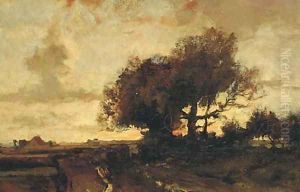Theophile Emile Achille Paintings
Théophile Émile Achille de Bock was a noted Dutch painter, part of the Hague School, which was a collective of artists who lived and worked in The Hague during the late 19th century. Born on January 14, 1827, in The Hague, Netherlands, de Bock was initially trained in commerce, following his family's wishes. However, his passion for art eventually led him to pursue a career in painting, a decision that marked the beginning of a significant contribution to Dutch landscape art.
De Bock's artistic journey began under the guidance of J.W. van Borselen, after which he moved to Brussels to study under the Belgian landscape painter Jean Baptiste Jongkind. His time with Jongkind, along with the influence of the Barbizon school in France, significantly shaped de Bock's style. He was particularly inspired by the Barbizon school's practice of painting en plein air (outdoors), which allowed him to capture the transient effects of light and atmosphere with a remarkable sense of immediacy and naturalism.
Throughout his career, de Bock was known for his moody, tonal landscapes that often depicted the Dutch countryside. His work is characterized by a muted palette and a sensitive handling of light, particularly the diffused light of cloudy or misty days. He had a unique ability to evoke the damp, lush atmosphere of the Netherlands, making his landscapes resonate with a quiet, introspective mood.
Despite his talents, de Bock never achieved the same level of fame as some of his contemporaries in the Hague School, such as Jozef Israëls or Hendrik Willem Mesdag. However, his contributions to the movement were significant, and his works were appreciated for their poetic and atmospheric qualities. De Bock was also an active member of the Pulchri Studio, an art society in The Hague, where he interacted with other artists and shared his ideas and artworks.
Théophile Émile Achille de Bock passed away on November 22, 1890, in Haarlem, Netherlands. Today, his works are held in various Dutch museums and continue to be appreciated for their contribution to the development of landscape painting in the Netherlands during the late 19th century. De Bock's dedication to capturing the essence of the Dutch landscape has cemented his place as an important figure within the Hague School and the broader history of Dutch art.
